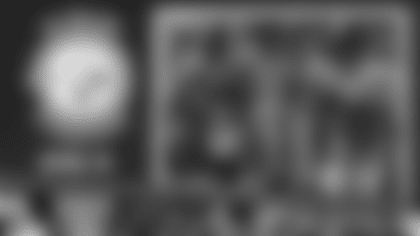**
Q. This is debated by football fans constantly: Is it the scheme, or is it the players?**
A. It's both. It always is. There really are no black-and-white answers to issues. If there were black-and-white answers, they wouldn't be issues. It's layers to issues, and it's always coaching, schematics, and players, in a combination of all three.
Q. Players have evolved over time. Are there schematic things that once worked in football 20-25 years ago that are still viable now given the way the game has changed?
A. In some instances, yes. In some instances, no. Thankfully I have been around long enough now that I'm capable of seeing the cycles. There are things that were hot 20 years ago, and then disappeared 10 years ago, and now they're back. And vice versa.
Q. Some examples of that?
A. I think we're on the cusp of the re-emergence of two-back football, particularly situationally. There are so many teams now that utilize a spread offense that two-back football is somewhat unique and people are ill-prepared to fit. Just like when two-back football was en vogue and the spread stuff was not, and therefore was unique when you saw it. I think the same thing can be said for the 3-4 defense. Years ago, there were somewhere between three-to-five teams running the 3-4 defense and so it was somewhat unique. In today's NFL there are roughly half the teams running the 3-4 defense, so it's less unique. Football has its cycles, and there are countless examples in regards to that.
Q. On the day after a game, there is a period on the daily schedule called "team meeting." What do you look to get accomplished during that time?
A. I summarize what happened and why, relative to our preparedness, for the sole purpose of increasing our chances of winning the next game. It's all about moving forward, but often times you have to look back and analyze an effort to do that efficiently. That's what Mondays are all about, regardless of the outcome of football games.
**
Q. Is it like a lecture format – you talk, they listen?**
A. It's a lecture format in that there's a possibility of the exchange of information through questions, but like in most lecture-type situations it's mostly me talking and them listening.
Q. Is it as matter-of-fact as a lecture, or is there a lot of emotion involved?
A. There's not a lot of matter-of-fact about it.
Q. On a typical pass play that's called in this league, is there such a thing as a primary receiver anymore?
A. Certainly. It can either be based on the design of the play, or the situation in which the play is called anticipating what the defense might call. There are schematic primaries, but there also are situational primaries. But I want every eligible receiver as he breaks the huddle to perform as if he's the primary. There is certain knowledge of intentions and situations, and particularly if a savvy veteran guy gets a pre-snap read on coverage often he can know where the ball's going to go. But the reality is you never know how things are going to unfold, and if you're an eligible you have to be prepared and present yourself in a manner in which you're the primary.
Q. How do you view this 3-3 Houston Texans team?
A. They've got some players who are really marquee guys in our business, and obviously it starts for us with minimizing their impact on the game. And they have those marquee guys in all three phases. On defense, they have J.J. Watt; on offense, they have Arian Foster at tailback and Andre Johnson at wide receiver; and on special teams I would be remiss if I didn't mention Shane Lechler, who is a legendary, legendary punter.
Q. What sticks out about Houston quarterback Ryan Fitzpatrick?
A. We've seen him quite a bit over the years, based on his years in Cincinnati and Buffalo. He's a savvy veteran guy, a quick decision-maker. He has better mobility than you think, and he's always looking to create things as the play breaks down. He's got a very good above-the-neck game, and we have a lot of respect for him.
Q. Is Arian Foster the quintessential outside-zone scheme running back?
A. He is, but he's more than that. He's got great pick-and-vision. He's somewhat of a glider, which means he's running faster and stronger than he appears. He's got a legitimate stiff-arm. He almost always wins in open grass against defensive backs. We have to get 11 guys to the ball, keep him boxed in. That's going to be a big challenge for us.
Q. What is the plan for defending Andre Johnson?
A. We're going to get in his face and challenge him. We can't be intimidated. We've had a good week of practice in that regard. He's got special skills, no doubt, but in today's NFL you're going to see guys with special talent week in and week out, and we have to meet the challenge head on.
Q. How do you block J.J. Watt?
A. It's not a one man job, and the Texans make sure of that because they move him around quite a bit. All five of our offensive linemen are going to get exposure to him, our tight ends are going to get exposure to him. They move him around to minimize the two-on-one situations you get on him. They do a great job schematically of helping him in that way, but he doesn't require much help. He's an awesome football player.






